TOURISM IN BUCOVINA
Traditions of Winter in Bucovina
Popular Traditions are an important component of tourism resources; available ethnographic Romania, representing and preserving mostly in rural areas of the country. They are particularly valuable integrates elements of spiritual culture popular being the definition, along with many other ethnic peculiarities of a people. They also print the community rules of conduct in social and family life, illustrates the depth of popular philosophy and the vision of life in all historical periods. Popular Traditions are very important for historical peculiarities of ethnogenesis our people, the history of philosophy, ethics, aesthetics and Romanian folk. Are grouped in four cycles consistent four seasons: spring habits, summer, autumn and winter, the latter being but the best preserved and most spectacular.
Traditions and practices, habits cycle winter holidays begin at Saint Nicholas (Sannicolaul) and ends in January at St.. John, they including a range, extremely rich in artistic expression, both in terms of literary folklore, music and choreographic and dramatic representations. But they excel and the richness and variety of items of clothing, props, decoration and even overhead, being a true carnival folk.
St. Nicholas
Saint Nicholas is at the beginning of winter (December 6), a joy for both the elderly and especially for children, the anticipation and then the arrival of Santa with gifts. Christian hagiography Although it appears as a real character, defender of the faith in Jesus, in the folk calendar is shown riding a white horse is sometimes herald winter brings snow. This Category Fair (in popular belief, deities of early winter appear under this title), Nicholas is gentle, wise and generous, helping widows and orphans, enables marrying poor girls, but most is adored by children, whom brings gifts on the night of December 5 to 6. Although careful and good with good children, Santa is pretty hard on the disobedient and lazy, who brings gifts instead of hazel rod that parents use them in applying the necessary corrections.
Bands, slopes, ţurca, hurta
"Ceata" was also a form of association is still young, a manifestation of a social fact or of folk customs. True cultural institution, fog for the winter holidays have a clear scenario outlined scenic and choreographic, with a certain load emotinala and repeating annually. Representing and pride of the village, often bands of different villages compete with each other, elements of hierarchy consisting of props and behavior....
Forms of association for the winter holidays have names different from one area to another: fog, hand, Turkey, Malanca. They begin to start is right after Christmas Lent. Young people entering the fog are selected according to certain criteria: they must have had a great attitude and conduct in question, know perfectly traditional customs which it belongs, have a nice voice, not to be tone deaf etc. It then appoints a head of fog, which has different names from one village to another, depending on troop profile: journeyman, governor, captain, Turkish or simply head lights. And it must meet certain requirements: to be the son of a big landowner to excel through dress and behavior, have a nice physical and not repulsive. He answers where rehearsals to take place, the props needed for bargaining musicians and during exercise program is carefully everything to proceed as expected.
Preparing costumes and props for the New Year bands, especially bands of irozi, emperors and bunghieri be done with the support of other people in the village. Usually the girls are contributing beads, scarves, fireworks and all other manufactures a bouquet of multicolored ribbons that adorn costumes.
Young people are rehearsing for games carols or masks during the entire Advent and especially after Santa Claus.
Ingatius of pig
Ignatius pig is a celebration dedicated to a solar deity and vegetables who took the name and date of celebration of a Christian saint - Bishop Theophan. On December 20 (Ignat) occurs pig sacrifice, a substitute for a pre-Christian deities of vegetation, dying and rising god at the winter solstice. Although still exist today several practices and customs of the ancient cult of the pig, very few people are aware of their significance.
First is parleste animal, thereby symbolizing death by incineration pre-Christian deity. Then I cut the pig tail and ears that are consumed on the spot by children, who straddles the slaughtered animal, thereby symbolizing dominance Christmas Lent is almost over. Cut his head and legs getting ready aspic (jelly), offered at Christmas, New Year and Epiphany ceremony as a preparation given and the souls of the dead. Then comes the total body chopping left and sacrifice of the pig, an ancient ritual ancestors worshiped.
There are still popular belief that during the pig slaughter, "one should not lie poke around the threads of the merciful, for they say that the animal dies hard and the meat is tasty."
Christmass
Christmas is the holiday that is stored in Bucovina, perhaps more than elsewhere, without much deviation from the past, the most beautiful and waiting time of year. He is prepared long before, with the beginning of Lent Christmas when they decide divisions of carols and carols to be learned and repeated. In Bucovina, Christmas caroling has been and still is not only a tradition, but by the organization, is a real institution with specific rules and regulations, very special.
Carols tradition still had charm 40 years ago, when with dark, homes were animated and alive with carols groups of lads who, throughout the night until around noon Christmas day traveling across lanes villages from one end to other. Dressed in peasant coats or coats with hats decorated with myrtle and geranium (journeyman with multicolored ribbons as personal insignia of the position they held), young people with or without accompaniment singing religious carols, carols carols for householders or girls. In the early twentieth century and until after the Second World War, the singers instrumental accompaniment consists only of flute and screen, and then expand the accompaniment of the band or, more recently, with other modern tools. Today, the tradition of carol singing was pretty diluted, meaning that young people do not longer meet the time for setting up the bands and traditional folk and other "laws" of the old carols were forgotten.
Each band carol primarily at the village hall, where receiving a license, then the priest, a teacher and the other houses in the village, most young people desire to carols girls being married. From exaggeration house, the yard and landowner activities, carols addresses different topics that capture the well-known allegorical reality. Fear hunting and the legendary curse breast long circulated in folklore from Bucovina, appears in local carols where the legendary character is transfigured in deer. Always carols not use satirical verses, only best wishes and good luck. If the girls married carols, the texts gift to glorify any girl even if it is ugly or lazy Christmas night all being treated the way superlative.
After wandering the house of young girls are invited to the front of that house and, formulas kindness, music starts playing and the young start the game. Their reward for wandering consist money, feasting and drinking, and journeyman remember, before departure, invite front of the house the next day to the village dance with parents.
In faith hairdryer, carols are spoken to disappear devils, to purify the atmosphere of the village the night Jesus was born, so they say, and now it is a shame to sit someone on Christmas night with the door closed.
If the day and night Christmas Eve carol walk with only children and young men, from the day until the Epiphany celebrations, those who wander are newlyweds, seniors and elders, its only going to neighbors, relatives or friends.
With all that entails and is, Christmas is and remains the crowning all holidays of the year, when the supreme deity is more tolerant and lenient, and man perceives a state of charity and care, well in general.
Between winter holidays, carols with the star is a common tradition to a wider European area by star singers immortalizing the great Christian event. In time, children associate in groups of three and had a star as props vesca made a sieve, which is staged "rays" of wood, everything is wrapped in colorful paper and tinsel. On the bottom of vesca was pasted a picture (icon) representing the religious scene of the birth of Jesus, as vesca is hanging a bell. Those who walk with the star or stellar called Magi, recalling the biblical characters Gaspar, Baltazar and Melchior, the star symbolizes the star that guided him in the middle night the three wise men to the place where Jesus was born. The head stelarii wore helmets made of colored paper, some outfit with a part that mimic the vintage look that is not preserved today. Starting in the 70s of last century, the custom of walking the star began to lose its importance, being practiced for quite some time only to poor children in the villages, because eventually be completely trivialized of the Roma population who practice it even with several days before Christmas.
Besides going with the star, churches and Herods, households still accustomed to go caroling every night, "one to another", thus achieving perfect communication in the bosom of human collectivities.
New Year
After the celebration of Christmas and celebrate moments after this holiday season mystery continue to cross the border from New times, introducing the man into another world, ruled by forces like hidden but able to influence the normal course of life, inradacinandu busi- in ancestral myth, linking unseen bridges between man and the cosmos, between man and environment, between man and people. Each of ceremonies is to transform mythical daily work (occupations, crafts, household chores, etc.) and critical stages of biological evolution of individuals (birth, caratoria death) in order to harmonize them with great timing and pace of biocosmosului.
The manifestations linked to New Year integrates hosts who went to plow, goats, bears, ravens, bungheri, emperors, Caiuti, Jieni, Codreni, babe and grandfathers coppersmith puppeteers, grooms and brides, devils etc., which are much richer in content.
Badly plow starts New Year's Eve. Children walk with small plow, a miniature plug, and draw their bells, bells, whips and flail mowers wool and adorned with tassels. The whip is long and braided codiristea thin as that used by carters to indemnatul horse; codoristea whip is thick, short and long braid and is usually used for cattle. Often tails whip and whip are ornamented with notches and is adorned with braided tassels and ribbons. Reaching under the window of the house of a householder, children begin to hate. Usually one speaks, the other shaking bells and snapped the whip. From props plow part and bittern, a little or a cuff, connected to a leather mouth beef. At the middle of the skin is a hole through which passes horsehair. By rubbing your hair with wet hands, bittern out a sound that accompanies the greeting. Sometimes bittern is decorated and put horns wrapped in colored paper and tassels. Children Umba with only small plow evening. At night, when the plow goes higher, they are retreating. Ugly big plow is made by lads and mature men. The plug adorned with ribbons, tassels, colored paper, green branches and bells and yoked cattle. Use and sea spray all existing props to plow small, including bittern. Fog can be higher. They walked from house to house with ugly abundance in the new year. The lyrics include the description of agricultural labor.
Besides Pluguşor of New Year many other customs practiced by groups of young men or adults. All the new year roll-theater complex looks popular, in which each character has its role, text, costume, mask and prop his own, based on a traditional kings, which always enriches even till date. Making a statistical character of the uratorilor known in Suceava, get to the following list: goat, deer, bear, horse, peacock, ostrich, chicken, Turkish, su new year year old old women, estates, Gypsies, mocanasii, demons, Turks, Cossacks, harapii, bumbierii, kings, generals, Newcastle, outlaws, queens, brides and grooms, doctors, landowners, merchants etc. Appearance on the streets of modern villages in the evening of New Year's Eve Bears, goat, deer, Caiuti, Bunghierilor, estates and babe, beautiful, ugly, etc. bull with Pluguşor and is determined not only by the sense of playful New Year's party, but also a much deeper motivation: belief that respecting the "law of the land" (habit inherited) people can achieve in the coming year, abundance and fertility the fields, flocks and orchards, and much needed health and strength.
The costumes for an outstanding fantasy, embodying the most bizarre creatures, masked with music and countless curious, begin to fill the streets of the village, causing the noise and making all sorts of ghidusii. The shelter masks, gestures and movements Mosilor Babe judanilor, Turks, Gypsies and other characters also get a symbolic value beyond normality and banality of the everyday. As the evening parade held in front of the crowd gathered in the village center is transferred to people's houses. Specific majority of settlements Bucovina is bringing all hidden characters in a single fog, called Malanca, Tape, Hurt or Turkish. This large group of masked characters can sometimes exceed a hundred people. Ruler of all is "Calfa" a nice lad, prepared and properly worthy of the trust of the entire village. Journeyman not wearing the mask. He is dressed in peasant clothes beautiful celebration and ceremony as a mark of rank it holds in Astrakhan wearing black hat, adorned with ribbons and beads, overlaid with brass and pewter hatchet. In the complex hordes type Malanca, usually each specific scenario - goat, bear, Caiuti etc. - takes place at a time, journeymen commanding order of their entry into the scene. Groups "ugly" and "beautiful" are designed to maintain an atmosphere of exuberant joy. "Ugly" ones are still amazing facts: the roll over, chase girls and their smut, get under beds, climb the trees, looking for the food pantry and pots etc. "Merchants" and "Căldărarii" disputing every little bit, and the dialogue is full of juicy irony.
Capra is a mito-zoomorphic character widespread in villages in Bukovina; She subordinated her all the other characters that surround it, "land", "babe", "shepherd", "bride" etc. Capra is a present fascinatorie which is characterized by excessive movement, managed to empower the entire assistance through ease and expressive pantomime outfit. In some villages, the number of goats can get 6-8 copies being surrounded by other masked characters without mythological identity. In traditional custom development, bands were formed goats separate. In other villages were integrated Malanca Bucovina goats. In this position, you must enter the house, they were called the Shepherds with shouts. The game takes place on the background music goat and shepherd utters humorous greetings. When you are sick and Goat Shepherd falls to the ground panic, shake and wearing a strange dialogue with the animal. When Capra revive, to the delight of all, jokes and ironies resume their course.
Bear is a presence as agreed in the New Year customs. Romanian space and implicitly in Bucovina, the bear cult has its origins in the dawn of civilization (Paleolithic). The Dacians bear was considered a sacred animal, multiple symbolic virtues. He also appears in the cult of Zalmoxis, its name being derived from the fur of the bear itself (Zalm = bearskin). From the rich symbolism of the bear have been preserved until today, some beliefs which certifies animal worship in Bucovina, more than in other areas of the country; perhaps because these lands have lived forever, Dacians. On the play ritual Bear - display of strength, vitality and dexterity - and now one can see glimpses highlighting beliefs regarding the bear as a symbol of perpetual regeneration plant. Bears roll in circles, beating and death, and resurrection miracle, metaphorically restore the seasons that are under the sign of the animal, able to defeat winter and really knows when spring comes. Bear playing with masks was mentioned in Bucovina more than in other areas of the country. Bear head mask enjoys special attention. Using almost the same materials, local creativity has imposed a variety typological extremely high. La Ostra, Stulpicani, Campulung the bear head shape is achieved calf stretching skin over a metal bucket. In Bosanci Plavalari Udesti and uses that support a metal frame that sits over the calf or lamb fur. A recent innovation occurs in villages Poieni Stirbat Racova, Chiliseni, Fantanele and financial headed bear a mascheta suggested that not only covers the front of the wearer's head. This kind of mask spectacular richness and diversity consists of ornaments which are applicable: multicolored ribbons, beads, tinsel, wool tassels, artificial flowers. Worthy to note the complexity of the ceremony, spectacular costumes and fastuozitatea is the common Udesti Bears game. Here bands reach 6-8 Bears, their game became symbolic reference element of custom New Year, dominating all other categories within Malancii masked. The bear is led by "Schinoasa" which urges to evolve in pace of local songs such as Ursareasca and shredded.
Deer in Romanian folk mythology symbolizes righteousness, purity, and the ancient Thracians was the symbol of the sun. In the old carols Bucovina deer appears between the horns wearing a silk swing that is "tiny Jesus, / Mic and infasel. / In the New Year customs, what impresses is fastuozitatea deer mask. Goat-like mask which consists all the jaw clampanitor head and a body made of a carpet or laicer mask deer and originality lies in its spectacular Herb: a trophy deer horns used to play, and each is decorative plastic made real composition of the various elements of ornament: beads, mirrors, tinsel, wool tassels, multicolored ribbons, artificial flowers and green plants etc. The game is structured ritual Stag Goat modeled with a pantomime exuberant and full of virtuosity. Stag is surrounded by "old men" and "Babe" Whistling and no mask dancers, dressed in beautiful costumes. In most villages in Bukovina, Stag individual appears as a band, not contaminated by other masked game. The most spectacular embodiment of deer masks can be seen from Corlat, Fundu Moldova, bathroom, Casvana and Moldova Valley.
Horse is another embodiment of powerful symbols Rumanian mythologized traditions and universal. Beautiful, agile, nimble, but also very nervous and unpredictable in its movements, the horse is an animal loved by villagers. In Bucovina horse-breeding has been practiced in many villages, accounting for the local horse animal not only pride but also the expression of a highly complex symbolism. From this perspective, the horse is the symbol of the tumultuous life and death. In the tradition of Bucovina horse has apotropaic function of protecting households and even churches. In the traditional customs of the New Year, Horse game (Caiutii) is practiced for these symbolic motivations, but also for the spectacular dance performed by carriers masks Cal. Young chose to wear this outfit ritual must be excellent dancers and connoisseurs of repertoire faultless area, because according to ancient beliefs, they are riders expressing youthful vitality and strength, virtuosity and exuberance, but smooth movements knowledge and wisdom. The most famous dancers from villages Dolhesti, Zvoristea, hollow and Fantanele. Here the players run in a circle or line - face to face - real "cavalry charge" rhythm melody local. Cal knows many variations Mask Bucovina plastics. Almost every village, horse head carved wood animal head and neck are covered with canvas colored (white, red or black), fitted with horsehair mane and richly decorated with mirrors, beads, colored ribbons, flowers and natural artificial, tinsel etc. To be worn during the game, the head is fixed in a wooden stand - a hole in the middle pan or two from hitting the screen - which is covered with a cloth or canvas as white skirt. Over these fabrics are sewn decorative elements (handkerchiefs, ribbons, towels etc).
Another category of ritual masks and costumes ample representation in Bucovina New Year customs are ugly. Head mask highlights the original and expressive, ugly and repulsive caricature the evils of human nature. Eyes, nose, mouth, ears and hair are cleverly metamorphosed to portray old age (MOSI Mosnegii Babe), ethnic identity (Gypsy, Hebrew, Turkish, Kazakh, Armenian), the specificity of some professions (trader, doctor, surgeon, ranger) and, not least, death and demons. Each character wearing hideous masks and robes as passing strange. During carols, ugly form independent groups to empower health and create good mood. In opposition to them and appear later in the New Year customs practiced in Bucovina, appear beautiful, "Emperor", "Minister", "General", "gendarme", "Bunghier" "Herods" "Queens" "Captains' etc. Many of these costumes are a way of irony to the authorities of the former Austro-Hungarian Empire. The most beautiful beautiful costumes appear in Bosanci Campulung Moldovan, Udesti, Reuseni, Russia-Manastioara and more recently, the Poieni-Udesti.
The boundary between the two categories of masked characters, "ugly" and "beautiful", and has appeared in the New Year customs - Peasant Wedding. Locally Created in the spirit of religious ceremonial structures, this event is a caricature approach, full of humor and irony, Bucovina traditional wedding. "Wedding procession" brings together, according to the canons area, all ranks ceremonial: the bride and groom, nose and Nanas, vatajeii and drustele, in-laws and wedding guests. Spectacle is grand: a procession of people dressed in his impeccable attire - costume populared maximum authenticity - with music, advances solemnly village streets. What attracts attention, however, is the mask that covers the main actors faces. In each cleverly defects are highlighted: the groom is a son little fat sometimes hunched and limping, the bride is tall and thin, contrasting sharply with her future husband. Vatajeii and drustele are also chosen to ridicule some flaws of human character. Nanasii perform their inside attribution, each doing what he had to do the other; all assistance to empower and create good mood.
Epiphany
Epiphany marked in the Christian calendar as the day when Jesus Christ was baptized, the feast that ends the 14-day renewal cycle time, days belonging holidays. Eve of Epiphany are excluded from food products frupt and girls who want to marry even keep fasting. Priests walk through the village, from house to house with the cross and holy water, and the groups of children that attended Chiraleisa speak in chorus, a cry with magical effects. To receive the priest, housewives preparing ritualistic food meals (corn crushed and boiled, sweetened with honey, prunes and stewed, stuffed with cereal etc.). After speaking Troparion baptism and sanctification table after the priest was obliged to sit on the Laita or bed "for breeders and come fall suitors at home." The priest received the money, the coil bucket and a bundle of hemp that we arrange the cross housewife, whose bundle of wires were to catch all the evil and on the Virgin Mary made bag that caught dead souls from hell and lead them heaven.
On Epiphany water is consecrated by job Jordan adding this Christian ritual and the more practice chasing the evil spirits by sprinkling holy water each other by splashing children, fountains, animals, farms, trees, through noise, the Shooting and fire ritual. In Bucovina, to end job Jordan Ardeasca practiced, usually by young people retreated to a higher place, especially around a fire lit in this regard. Of dried leaves and twigs gathered the day before, young lit a fire around the place where the crowds were gathered and sang and played around it. How to decrease the flame, jumping over the fire and the smoke to be clean of disease and to fulfill all desires. From the fire and coals were taken at various practices used fertilizer and defense role.
At the end of the job Jordan, people are returning home in groups and shouting "Chiraleisa, Chiraleisa ..." in hopes of good harvest and if you encounter wells in each little bit about throwing holy water taken tocopherol.
In Bucovina today are still wandering the Epiphany, charms and spells to do is prophesy crops and weather.
Information taken from: - Michael Camilar, notch and magical seals. A popular calendar Bukovina, Department for Culture, Cults and National Cultural Heritage and Folk Customs Museum in Suceava Bucovina-Gura Humor, Suceava, 2009.
Traditional crafts of Bucovina
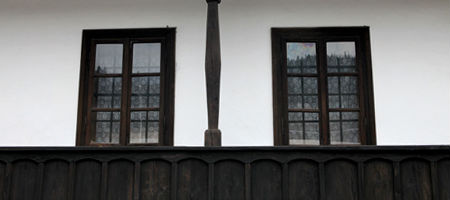 Bucovina is known for its folk costumes, furniture, pottery, tapestry and carpets. Every detail of these crafts reflects the history and cultural heritage of the region, while being unique occupations that can be transmitted from one generation to another. In addition, complex works of art, painted like Easter eggs, braided bread, popular masks and traditional costumes are made to celebrate certain religious holidays.
Bucovina is known for its folk costumes, furniture, pottery, tapestry and carpets. Every detail of these crafts reflects the history and cultural heritage of the region, while being unique occupations that can be transmitted from one generation to another. In addition, complex works of art, painted like Easter eggs, braided bread, popular masks and traditional costumes are made to celebrate certain religious holidays.
Examples of this art are exhibited in folk art museums throughout the Bukovina.
Egg Decoreation
A treasure trove of popular culture in Bukovina, craft încondeierii eggs is closely related to the art of embroidery and decor that are on the national costumes. All these arts transform commonplace in a particularly beautiful.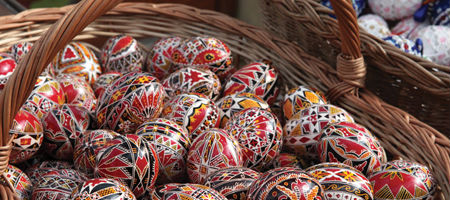
The egg is human existence and history of ancient philosophy, a testimony to the customs, beliefs and customs of Easter.
The craft is learned in the family and passed on from generation to generation. For expert eye there is an abundance of creativity expressed by various techniques work and personal styles.
The uninitiated will find a feast of colors, a true test of patience and a unique passion and soul that delights sight.
Craft of "încondeia 'eggs seen in the harmony of colors, patterns delicacy passed down from generation to generation and execution skills, lifting the craft to an art.
Eggs are painted in three to four colors usually given each color and symbol part: red (sun, fire, love), black (eternity, constancy, absolutism), yellow (light crop wealth, youth, hospitality ), green (power of nature, fertility, hope, freshness), blue (health, blue sky), purple (străpânire self, patience, trust, right) painted egg color palette makes the difference between the main areas where practice this craft .
The red zone is specific Brodina black Ciocăneşti area, green and blue or orange Ulma Moldova.
Eggs are painted in three to four colors usually given each color and symbol part: red (sun, fire, love), black (eternity, constancy, absolutism), yellow (light crop wealth, youth, hospitality ), green (power of nature, fertility, hope, freshness), blue (health, blue sky), purple (străpânire self, patience, trust, right) painted egg color palette makes the difference between the main areas where practice this craft .
From decorating eggs distinguish geometric symbols and meanings as:
- straight vertical line - life;
- horizontal straight line - death;
- double line right - eternity;
- line with rectangles - thought and knowledge;
- swirly line - water cleaning;
- spiral - time, eternity
Icon painting
Occupying an important place in our creations popular creators in the area required a way of painting on glass and local wood, taking scenes from frescoes monasteries of Bucovina and old engravings, replicas of traditional icons and images of local customs and occupations.
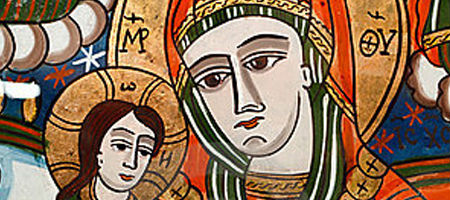 In this land of monasteries, picture icons on wood, worked in the Byzantine style, using formulas handed down over many generations.
In this land of monasteries, picture icons on wood, worked in the Byzantine style, using formulas handed down over many generations.
Painting icons on glass, is carried on its back so that it serves both as a support for painting, as well as gloss painted surface. A special feature of the work done in this area of the drawing is a remarkable finesse and sobriety of color.
Icons on glass and wood are of rare beauty Bucovina artistic pointing out the colors used, not exceeding altiţelor geometric palette ranging from blue blood Voroneţ to aureolelor colors, which mostly are worked gold leaf.
Pottery
One of the oldest crafts, pottery emerged as a necessity for people to prepare and preserve food. Now this craft is continued by artisans and potters in Radauti Radauti Marginea.Specificul vessels is the colors used for decoration. Such vessels are drawn with geometric or floral brown, green, or yellow, or red background alb.Ceramica the edge is already a well known brand in the world. Black pottery is a testimony of Dacian origin, it is now meeting only at the edges. Technique to achieve the same vessels used hundreds of years ago, but adapted to our times.
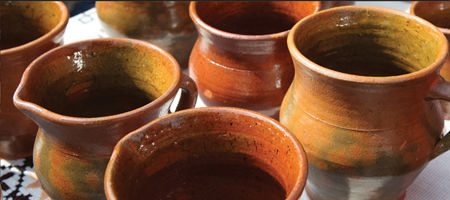 While in the past large vessels were burned in pits 1.5 m, the shape of a cone with the top up, which was a hole with smaller communicating through a channel that was the first and the fire burning today furnaces is closed at the top and at the mouth of fire. Gray or black color is given by the burning of oxygen.
While in the past large vessels were burned in pits 1.5 m, the shape of a cone with the top up, which was a hole with smaller communicating through a channel that was the first and the fire burning today furnaces is closed at the top and at the mouth of fire. Gray or black color is given by the burning of oxygen.
Forms are also vessels or from ancient times: high pot, large pot or bowl with two handles or modern: vases, plates, cups. The technique of decorating is all traditional: the vessels are polished with a special stone, such as gray traces still remaining unburned vessel walls to mix with black.
Weaving
Weaving has a special place in traditional craft. Weaving and sewing were done in family occupations represented core part of women is a reality today in the village of Bucovina.
The most numerous items are for adornment and decoration woven locuiţelor interior.
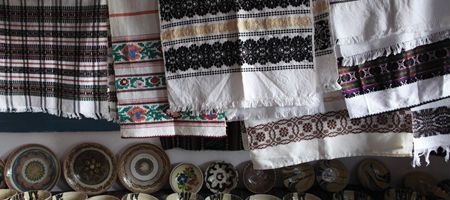 Thus, weave carpets, rugs or wool paretare colored with geometric or floral towels for interior decoration of houses or other events that mark moments in human life (marriage, death).
Thus, weave carpets, rugs or wool paretare colored with geometric or floral towels for interior decoration of houses or other events that mark moments in human life (marriage, death).
Noteworthy are checked bag fabrics specific mountain area.
For weaving various warfare pieces used the same horizontal (standing), but changing rolls, shoulders, sometimes threads and ironing. The same state and wove cloth and carpets.
Folk Outfit
Folk highlights the talent and sensitivity to play the inhabitants of these areas, who wear these clothes holidays.
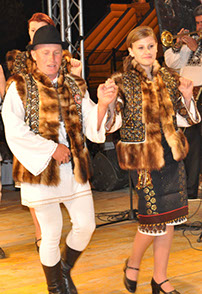 As in the past, women working Bucovina costumes manually using folk motifs: ear, sun, leaves, and not least, the cross symbolizing faith in God.
As in the past, women working Bucovina costumes manually using folk motifs: ear, sun, leaves, and not least, the cross symbolizing faith in God.
Female port consists of a shirt richly adorned with floral and geometric, a skirt woven with golden thread, which is tied at the waist with colored waist and feet wearing sandals. In winter, women wear Bundle, wool socks and scarves.
Male port consists of a long shirt, showing geometric embroidery generally black or brown in color, tied in the middle with a leather belt, a vest (Bundle) with white skin in addition decorated with floral or geometric and additions marten fur and fur inward iţari of wool per lamb leather hat and standing sandals.
There are some clothes for cold seasons or overcoat used fall - is made from a thick wool coat - and coat - a knee-length coat with fur and skin turned inside out, decorated with embroidered flowers.
Regardless of the ethnographic, folk beauty of Bucovina has gone around the world, everywhere is admired and appreciated.
Folk Masks
Making masks popular folk tradition is closely linked especially winter holidays. In the winter habits conducted in the villages, the mask has a very important role.
For making masks using animals (sheep, goat, bear), leather, carved wood, bark, metal, beads, beans.
These masks have a rich emotional, representing the general transposition of animals such as goats, horses, bears, wolves, deer or some popular mythology or folklore.
Inițiativă locală. Dezvolater regională
www.inforegion.ro
Investim în viitorul tău!
Proiect selectat în cadrul Programului Operaţional Regional şi co-finanţat de Uniunea Europeană prin Fondul European pentru Dezvoltare Regională.
Conţinutul acestui material nu reprezintă în mod obligatoriu poziţia oficială a Uniunii Europene sau a Guvernului României.
Toate drepturile de autor aparţin U.A.T. Câmpulung Moldovenesc şi Consiliului Judeţean Suceava